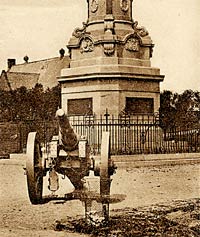Military associations with Calderdale

Early illustrations of Halifax show soldiers in the streets dressed in their scarlet coats and white or buff breeches and wearing cocked hats. Halifax raised the 33rd Regiment of the Line (the Haver Cake Lads) in 1793, and in 1803 formed a regiment of Volunteers. In 1812 the Local Militia was formed, and the Morley and Abbrigg Yeomanry also covered the Halifax district. The 6th West York Militia was raised in 1854, and in 1871 the Artillery Corps was formed.
Sir Henry Edwards (1812-86) was one of the prominent Halifax gentry who became an officer in the volunteer force. He helped to raise the First West York Yeomanry Cavalry in 1843 and in the following year was elected captain. The Morley and Agbrigg Corps of the Yeomanry Cavalry was then designated the Second West York Yeomanry Cavalry. Sir Henry was promoted Lt-Colonel and commanded the regiment for 21 years, retiring in 1884 after a total of 41 years service.
Edward Akroyd (1810-87), the Halifax mill owner and philanthropist helped to form the Volunteer Rifle Corps in 1859 and was appointed senior captain. The battalion was designated the 4th West Yorkshire (Halifax) Rifle Volunteers. Parades were held at first in the Piece Hall and later in the Riding School. Akroyd was promoted to Lt-Colonel in 1861, and in 1870 a Drill Hall was built for the use of the Volunteers. On relinquishing command of the regiment in 1870 he received the title of Honorary Colonel. In 1883 the title of the unit changed to the First Volunteer Battalion (Duke of Wellington's) West Riding Regiment, and a further change took place in 1908 when it became the 4th Battalion (Duke of Wellington's) West Riding Regiment. In 1938 it changed once more to the 58th Anti-Tank Regiment, R.A. Louis John Crossley, JP, (1842-91) the only son of Mr John Crossley, MP, of Manor Heath, Halifax, was another Halifax gentleman who thought it his duty to serve as an officer in the Volunteers and became Colonel of the 2nd West York Artillery Volunteers.
Cavalry were trained at the Riding School which stood opposite the present Halifax Bank headquarters in Halifax. Early maps also show a site marked 'Cavalry Fields' where exercises clearly took place. This was situated above Rhodes Street, between Gibbet Street and Hanson Lane.
The Duke of Wellington's Regiment has long associations with Halifax and recruited in the Calderdale district from its inception. The regiment was originally the 33rd Foot and served in India and in Europe. This eventually became the Duke of Wellington's Regiment after the Duke's victory at Waterloo.
Wellesley Barracks, named of course after the Duke's family, were built in the Highroad Well district of Halifax in 1877 and became the depot for the regiment where troops were quartered behind its castellated walls and towers for many years until the depot and training base of the Duke of Wellington's Regiment was moved to Strensall and Wellesley Park, as it was then renamed, was used by Calderdale Leisure Services Department.
Major-General Sir William Fawcett, KCB (1728-1804) who was born in Halifax was connected to the Listers of Shibden Hall. He obtained a commission in the army becoming an Ensign in 1745, captain in 1757, and rising to Lt-Colonel in 1760, Major-General in 1777, Lt-General in 1782 and General in 1796. His wide service abroad included the Seven Years' War and the American War of Independence. He was an informed writer on military affairs and in 1799 was honoured by becoming a Privy Councillor.
Captain Jeremy Lister (1752-1836), who was born at Shibden Hall and was to become the father of Anne Lister, obtained a commission as an Ensign in the 10th Regiment of Foot in 1770, joining his regiment in Canada the following year where he was wounded. His journal tells some of his adventures there and includes also more mundane details such as the price of items of his uniform. He rose to the rank of captain, but resigned his commission in 1783. He died in 1836.
During World War 2 Halifax was a garrison town, its streets echoing to the tramp of marching feet and the roar of heavy military vehicles, and its citizens played their part, many young men and women joining the armed services while those at home went on duty as Air Raid Wardens after a full day's work, or served as Fire Watchers or with the Civil Defence. Other men, those too old or too young for service in the forces, became members of the Home Guard and prepared for the possibility of invasion.
An interesting link with Bomber Command was the official naming of an aeroplane as the 'Halifax' bomber.
Themes
- Calderdale architecture
- Canals in Calderdale
- Chartism
- Colonel Edward Akroyd
- Crossley and Porter School
- Crossley family
- Factory conditions
- Famous people of Calderdale
- The manorial fulling mill
- Growth of education in Calderdale
- Halifax cinemas
- Halifax Moot Hall
- Halifax Theatres
- Hudsonites
- John Fielden
- John Mackintosh
- Military associations with Calderdale
- Musical associations of Calderdale
- Piece Hall
- Plug riots
- Poor law
- Railways in Calderdale
- Role and influence of women in Calderdale
- Social welfare
- Turnpike Roads in Calderdale
- Wainhouse Tower
- World War One
- Yorkshire Coiners


